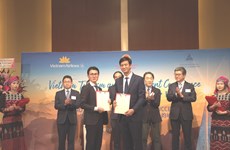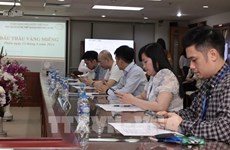Vietnam hopes to woo more Japanese investors
Vietnam considers Japan to be a prioritised market for trade promotion
activities and is working hard to attract more investment from the
Northeast Asian giant, according to Nguyen Van Trung, Deputy Minister of
Planning and Investment.
Vietnam considers Japan to be a prioritised market for trade promotion
activities and is working hard to attract more investment from the
Northeast Asian giant, according to Nguyen Van Trung, Deputy Minister of
Planning and Investment.
Forty years after the two countries began their diplomatic relationship, Vietnam and Japan have seen a considerable development in their economic ties, particularly foreign direct investment (FDI) attraction from Japan .
Japan’s investment in Vietnam has increased in recent years and it injected money in 144 projects worth 2.37 billion USD in 2010. The number of projects rose to 317 valued at 5.6 billion USD in 2012, doubling the previous investment. In the first nine months of this year, Japan continues taking the lead with 210 projects and a registered capital of 4.7 billion USD.
To absorb the Japanese investment wave, Vietnam has carried out a wide range of investment promotion programmes in order to present the country’s fertile investment climate, Deputy Minister Trung told the Vietnam News Agency.
The ministry also implemented measures to ease obstacles for Japanese investors operating in Vietnam through the Vietnam-Japan Joint Initiative. He added that there has been acceleration in the establishment of offices in Japan offering advice to potential investors.
However, the minister conceded that investment from Japan does not match the two countries’ potential, with Vietnam failing to effectively take advantage of the capital flow. Weakness in the supporting industry is one of the main reasons for the shortcomings as it often falls short of the demands listed by Japan ’s FDI projects, especially major ones in vehicle and electronics production.
The Deputy Minister attributed poor infrastructure and inefficient human resources to the shortcomings.
He admitted that the low proportion of domestic materials in production is also clouding Vietnam ’s investment climate in comparison to other regional countries.
He emphasised the need to solve the shortcomings in order to increase the country’s competitiveness and continue attracting FDI.
The Prime Minister issued a decision last July ratifying Vietnam ’s industrialisation strategy within the Vietnam-Japan cooperation framework to 2020 with vision 2030 in a move to improve the situation. Accordingly, six industries have been defined for further development: electronics, agricultural and seafood processing, agricultural machinery, environment and energy saving, automobile and spare part production and ship building. A number of solutions have been mapped out to increase production capacity.
Regarding the essential development of the supporting industry, the Government approved the ministry’s proposal to target FDI projects that require a large volume of domestic material. In the longer-term, a law developing the support industry will be created and implemented.
Commenting on Vietnam ’s advantages in attracting FDI from Japan , Deputy Minister Trung said that Japanese businesses are interested in the quality of human resources in Vietnam , despite labour costs rising.
In a bid to improve the quality further, the Prime Minister has adopted the Vietnam human resources development strategy 2011-2020, which targets raising the number of trained labourers to 55 percent by 2015 and 70 percent by 2020 along with the construction of four international-standard universities and 10 vocational training schools by 2020.
Japan has to date run 2,047 valid FDI projects in Vietnam with a total registered capital of 33.4 billion USD. It is Vietnam ’s biggest investor, accounting for 15 percent of the Southeast Asian nation’s FDI registered capital.
Japan’s investment mainly pours into the manufacturing industry, making up 83.7 percent of its investment and 24 percent of the total foreign investment in the industry, which has helped serve Vietnam’s goals of industrialisation and modernisation.-VNA
Forty years after the two countries began their diplomatic relationship, Vietnam and Japan have seen a considerable development in their economic ties, particularly foreign direct investment (FDI) attraction from Japan .
Japan’s investment in Vietnam has increased in recent years and it injected money in 144 projects worth 2.37 billion USD in 2010. The number of projects rose to 317 valued at 5.6 billion USD in 2012, doubling the previous investment. In the first nine months of this year, Japan continues taking the lead with 210 projects and a registered capital of 4.7 billion USD.
To absorb the Japanese investment wave, Vietnam has carried out a wide range of investment promotion programmes in order to present the country’s fertile investment climate, Deputy Minister Trung told the Vietnam News Agency.
The ministry also implemented measures to ease obstacles for Japanese investors operating in Vietnam through the Vietnam-Japan Joint Initiative. He added that there has been acceleration in the establishment of offices in Japan offering advice to potential investors.
However, the minister conceded that investment from Japan does not match the two countries’ potential, with Vietnam failing to effectively take advantage of the capital flow. Weakness in the supporting industry is one of the main reasons for the shortcomings as it often falls short of the demands listed by Japan ’s FDI projects, especially major ones in vehicle and electronics production.
The Deputy Minister attributed poor infrastructure and inefficient human resources to the shortcomings.
He admitted that the low proportion of domestic materials in production is also clouding Vietnam ’s investment climate in comparison to other regional countries.
He emphasised the need to solve the shortcomings in order to increase the country’s competitiveness and continue attracting FDI.
The Prime Minister issued a decision last July ratifying Vietnam ’s industrialisation strategy within the Vietnam-Japan cooperation framework to 2020 with vision 2030 in a move to improve the situation. Accordingly, six industries have been defined for further development: electronics, agricultural and seafood processing, agricultural machinery, environment and energy saving, automobile and spare part production and ship building. A number of solutions have been mapped out to increase production capacity.
Regarding the essential development of the supporting industry, the Government approved the ministry’s proposal to target FDI projects that require a large volume of domestic material. In the longer-term, a law developing the support industry will be created and implemented.
Commenting on Vietnam ’s advantages in attracting FDI from Japan , Deputy Minister Trung said that Japanese businesses are interested in the quality of human resources in Vietnam , despite labour costs rising.
In a bid to improve the quality further, the Prime Minister has adopted the Vietnam human resources development strategy 2011-2020, which targets raising the number of trained labourers to 55 percent by 2015 and 70 percent by 2020 along with the construction of four international-standard universities and 10 vocational training schools by 2020.
Japan has to date run 2,047 valid FDI projects in Vietnam with a total registered capital of 33.4 billion USD. It is Vietnam ’s biggest investor, accounting for 15 percent of the Southeast Asian nation’s FDI registered capital.
Japan’s investment mainly pours into the manufacturing industry, making up 83.7 percent of its investment and 24 percent of the total foreign investment in the industry, which has helped serve Vietnam’s goals of industrialisation and modernisation.-VNA













